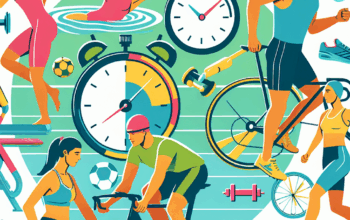The Role of Proper Warm-Up in Preventing Sports Injuries
Every athlete, whether an amateur or a professional, knows the importance of a proper warm-up routine. Engaging in sports without adequate preparation not only diminishes performance but significantly increases the risk of injuries. The role of proper warm-up in preventing sports injuries is a critical topic, especially in 2025, as athletes continue to push the limits of their bodies. As we explore this essential aspect of athletic training, we will unveil the physiological benefits of warming up, effective warm-up techniques, and how these practices can prolong athletic careers by minimizing injury risks.
Understanding the Importance of Warming Up for Athletes
Warming up prepares the body for physical activity by gradually increasing the heart rate and blood circulation to the muscles. This physiological response enhances the oxygen supply and nutrient delivery essential for muscle function, allowing athletes to perform at their peak. A structured warm-up routine comprises dynamic stretching and light aerobic exercises designed to improve joint mobility, flexibility, and overall performance. The significance of properly warming up cannot be overstated, as it plays a fundamental role in injury prevention.
Moreover, warming up is not just about physical preparation; it is also a mental rehearsal for athletes. Engaging in warm-up activities helps athletes focus and mentally transition into their performance zone, reducing anxiety and increasing confidence. This mental readiness can also help in honing motor skills that are crucial for executing complex movements efficiently during competition or practice.
How Proper Warm-Up Techniques Reduce Injury Risk
Injuries in sports often stem from a sudden increase in activity without adequate preparation, leading to strains, sprains, and other musculoskeletal conditions. Proper warm-up techniques target the specific muscle groups that will be used during the sport, ensuring that the body is primed and ready for intense physical exertion. For instance, athletes involved in high-impact sports such as basketball or soccer should prioritize warm-ups that mimic the sudden movements and intensity of their game to enhance their body’s adaptability and response.
Furthermore, the process of warming up activates the synovial fluid in the joints, serving as a lubricant that reduces friction during movement. This preparation is vital in minimizing the wear and tear on joints, as well as mitigating the likelihood of conditions such as tendonitis and arthritis. By incorporating a systematic warm-up routine into training regimens, athletes can substantially lower their risk of acute and chronic injuries, fostering a sustainable athletic career.
Common Methods of Warming Up and Their Effectiveness
There are various methods of warming up that athletes can employ to minimize injury risks effectively. Dynamic stretching, which involves moving parts of the body through a full range of motion, is one of the most beneficial techniques. Unlike static stretching, dynamic stretching prepares muscles for action by mimicking the movements that will be performed in the sport. Activities such as leg swings, arm circles, and high knees activate the major muscle groups and are particularly effective in raising the body temperature and enhancing flexibility.
In addition to dynamic stretching, sport-specific drills can serve as excellent warm-up exercises. For instance, runners may incorporate short sprints or stride-outs into their warm-up, while soccer players could focus on dribbling and passing drills to engage relevant muscle groups and promote motor memory. Such targeted warm-up routines not only prepare the body physically but also help in sharpening the neural pathways necessary for executing skills under competitive conditions.
Moreover, the effectiveness of any warm-up routine can be enhanced through a structured approach. Athletes should aim to allocate ample time for warming up—generally around 10 to 15 minutes—beginning with low-intensity activities that gradually escalate in intensity. This gradual progression is crucial in preventing overstretching and potential injuries while ensuring that the body adapts optimally to the increased workload.
Incorporating Technology in Warm-Up Routines
As we progress into 2025, technology’s role in sports training has become increasingly sophisticated. Wearable devices that monitor physiological metrics such as heart rate, body temperature, and even muscle engagement provide valuable feedback that can enhance warm-up routines. Coaches and athletes can utilize data gleaned from these devices to tailor their warm-up sessions to specific needs, addressing individual vulnerabilities and optimizing performance.
Additionally, virtual and augmented reality technologies are now being employed in warm-up sessions to simulate real-life game scenarios. Athletes can engage in virtual drills that replicate the dynamics of their respective sports, offering a comprehensive preparatory experience that includes both physical and cognitive readiness. This innovative approach not only keeps warm-up sessions engaging but also prepares athletes for the quick decision-making needed during actual competition.
Furthermore, advancements in biomechanical analysis have led to the development of programs that can evaluate movement patterns and identify potential risk factors for injury. By employing these assessments during warm-ups, athletes can refine their movements and adopt safer techniques—ultimately contributing to enhanced performance and injury prevention.
The Role of Coaches and Trainers in Warm-Up Protocols
Coaches and trainers play a pivotal role in establishing effective warm-up protocols for athletes. Their experience and expertise in sports science allow them to design comprehensive warm-up routines tailored to the needs of their athletes. By incorporating evidence-based practices into warm-up sessions, these professionals create an environment that emphasizes injury prevention while promoting high performance.
Moreover, continuous education and awareness regarding the latest research on injury prevention are paramount for coaches. This knowledge enables them to adjust warm-up routines based on emerging insights and trends that influence athletic performance and safety. For instance, understanding the risks associated with particular sports or recognizing the importance of sport-specific warm-ups can help coaches better prepare their athletes for the demands of their disciplines.
In addition, fostering an open line of communication with athletes about the importance of warming up is essential. When athletes understand how warming up minimizes injury risks and enhances their performance, they are more likely to commit to their warm-up routines. Coaches can encourage this awareness by discussing specific warm-up activities and their physiological impacts, ultimately empowering athletes to take ownership of their preparation.
Conclusion
The role of proper warm-up in preventing sports injuries is crucial in the ever-evolving landscape of athletics. By understanding the importance of warming up, incorporating effective techniques, leveraging technology, and promoting awareness through coaching, athletes can significantly reduce their risk of injury while enhancing their overall performance. As we move forward into 2025 and beyond, prioritizing warm-up routines will remain a fundamental aspect of athletic training, ensuring that athletes can continue to push their limits safely and successfully.
FAQs
What are the key components of a proper warm-up routine?
A proper warm-up routine typically includes light aerobic exercise, dynamic stretching, and sport-specific drills, all aimed at gradually increasing heart rate, improving flexibility, and preparing the body for physical exertion.
How long should a warm-up session last?
Ideally, a warm-up session should last between 10 to 15 minutes to allow sufficient time for the body to adjust to increased activity levels.
Can I skip warm-ups if I’m short on time?
Skipping warm-ups is not recommended, as it significantly increases the risk of injuries. Instead, try to engage in a condensed warm-up routine that still incorporates key elements to prepare your body effectively.












